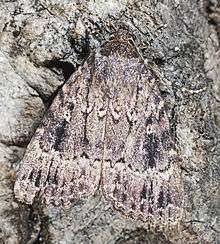Copper underwing
| Amphipyra pyramidea | |
|---|---|
 | |
| Copper underwing moth | |
 | |
| Copper underwing larva | |
| Scientific classification | |
| Kingdom: | Animalia |
| Phylum: | Arthropoda |
| Class: | Insecta |
| Order: | Lepidoptera |
| Family: | Noctuidae |
| Genus: | Amphipyra |
| Species: | A. pyramidea |
| Binomial name | |
| Amphipyra pyramidea (Linnaeus, 1758) | |
The copper underwing, humped green fruitworm, or pyramidal green fruitworm (Amphipyra pyramidea) is a moth of the family Noctuidae. It is distributed across the Palaearctic region including north India, Korea and Japan.

This species has a wingspan of 47–54 mm, the female usually slightly larger than the male. The forewings are brown marked with paler fascia and a pale, dark-centred stigma. The hindwings are a rich bright copper colour. It is very similar to Svensson's copper underwing (Amphipyra berbera) but identification is usually fairly straightforward by looking at the underside of the hindwings: This species has a pale area in the centre, contrasting with much darker marginal areas while in A. berbera the whole underwing is more or less uniform in colour.
Larva can be found as early as April in some climates but usually emerge in May-June. Hatching season is as early as June in some climates but usually hatch July to October. A pyramidea flies at night from August to October and is attracted to light and strongly to sugar.
The larva is green with white markings and a pointed hump at the rear end. It feeds on a variety of trees and shrubs (see list below). The species overwinters as an egg.
- ^ The flight season refers to the British Isles. This may vary in other parts of the range.
Recorded food plants
- Fraxinus - ash
- Ligustrum - privet
- Lonicera - honeysuckle
- Malus - apple
- Quercus - oak
- Rhododendron
- Rosa - rose
- Sorbus - wild service tree
- Syringa - lilac
See.[1]
References
| Wikimedia Commons has media related to Amphipyra pyramidea. |
- Chinery, Michael Collins Guide to the Insects of Britain and Western Europe 1986 (Reprinted 1991)
- Skinner, Bernard Colour Identification Guide to Moths of the British Isles 1984
External links
- Lepiforum Includes photo of genitalia
- Funet Taxonomy
- Fauna Europaea